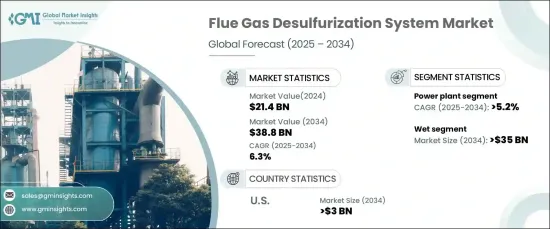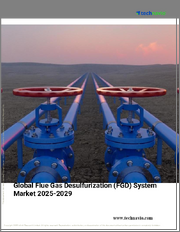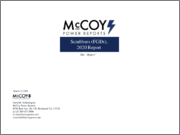
|
시장보고서
상품코드
1666924
배연 탈황 시스템 시장 : 기회, 성장 촉진요인, 산업 동향 분석 및 예측(2025-2034년)Flue Gas Desulfurization System Market Opportunity, Growth Drivers, Industry Trend Analysis, and Forecast 2025 - 2034 |
||||||
세계의 배연 탈황 시스템 시장은 2024년 214억 달러로 평가되었고 2025년부터 2034년까지 6.3%의 안정적인 CAGR로 성장할 것으로 예상됩니다.
에너지 수요의 증대는 산업 배출물 증가를 초래해, 중대한 환경 과제의 원인이 되고 있습니다. 발전소나 산업시설에 의한 대기오염에 대한 우려가 높아지는 가운데, 세계 각국의 정부나 정책 입안자는 보다 엄격한 배출 규제 대책을 중시하고 있습니다.

새로운 제조시설과 산업거점의 설립으로 산업활동의 급속한 확대는 견고한 환경규제 도입의 긴급성을 더욱 두드러지게 하고 있습니다. 산업활동의 격화에 따라 이산화황(SO2)과 같은 유해오염물질의 배출이 증가하고 있으며, 배연 탈황 시스템와 같은 고급 배출제어기술의 필요성이 부각되고 있습니다.
| 시장 범위 | |
|---|---|
| 시작 연도 | 2024년 |
| 예측 연도 | 2025-2034년 |
| 시작 금액 | 214억 달러 |
| 예측 금액 | 388억 달러 |
| CAGR | 6.3% |
습식 배연 탈황 시스템 시장은 2034년까지 350억 달러 이상에 달할 것으로 예상됩니다. 이러한 시스템은 산업 배출물로부터 이산화황과 미립자 물질을 줄이는데 매우 효율적이기 때문에 진화하는 환경 기준을 준수하는 산업에 인기있는 옵션이되었습니다. 대기오염물질과 폐수오염물질 모두를 관리하는 습식 FGD 시스템의 효능은 에너지 다소비용 부문에서 중요한 솔루션으로 자리매김하고 있습니다.
FGD 시스템은 발전 용도에서도 인기를 끌고 있으며, 이 분야는 2034년까지 연평균 복합 성장률(CAGR) 5.2% 이상의 성장이 전망되고 있습니다. 경제개발과 산업화에 의해 전력 수요가 계속 증가하는 가운데, 배출레벨을 억제하기 위한 선진기술의 채용이 필수적입니다. 배연 탈황 시스템는 이산화황의 배출을 줄이고 발전소에서 엄격한 환경 지침을 준수하는 데 필수적입니다.
미국의 배연 탈황 시스템 시장은 2034년까지 30억 달러 이상에 달할 것으로 예상됩니다. 정부의 이니셔티브와 자금 지원에 의해 지원되는 배출 억제 기술에 대한 투자는 시장 성장을 뒷받침하고 있습니다. 이러한 진보는 첨단 시스템의 도입 비용을 줄이는 데 도움이 되고 보급의 길을 열고 있습니다.
아시아태평양에서는 에너지 인프라와 배출 제어 기술의 통합을 위한 노력이 배연 탈황 시스템의 도입을 가속화하고 있습니다. 협력적인 지역적 접근과 산업 거점에 대한 중점적인 노력은 대기 오염 감소의 진전을 촉진하고, 이 지역에서 시장 성장을 지원하고 있습니다. 이 전략은 세계적으로 배연 탈황 시스템의 채용이 더욱 진행될 것으로 예상됩니다.
목차
제1장 조사 방법과 조사 범위
- 시장 범위와 정의
- 시장 추계·예측 파라미터
- 예측 계산
- 데이터 소스
- 1차
- 2차
- 유료
- 공적
제2장 주요 요약
제3장 업계 인사이트
- 업계 생태계 분석
- 규제 상황
- 업계에 미치는 영향요인
- 성장 촉진요인
- 업계의 잠재적 리스크 및 과제
- 성장 가능성 분석
- Porter's Five Forces 분석
- 공급기업의 협상력
- 구매자의 협상력
- 신규 참가업체의 위협
- 대체품의 위협
- PESTEL 분석
제4장 경쟁 구도
- 서론
- 전략적 전망
- 혁신과 지속가능성의 전망
제5장 시장 규모와 예측 : 기술별(2021-2034년)
- 주요 동향
- 습식
- 건식
제6장 시장 규모와 예측 : 용도별(2021-2034년)
- 주요 동향
- 발전소
- 화학 및 석유화학
- 시멘트
- 금속가공 및 광업
- 제조
- 기타
제7장 시장 규모와 예측 : 지역별(2021-2034년)
- 주요 동향
- 북미
- 미국
- 캐나다
- 멕시코
- 유럽
- 독일
- 영국
- 프랑스
- 스페인
- 이탈리아
- 아시아태평양
- 중국
- 인도
- 일본
- 한국
- 인도네시아
- 호주
- 베트남
- 중동 및 아프리카
- 사우디아라비아
- 아랍에미리트(UAE)
- 남아프리카
- 나이지리아
- 라틴아메리카
- 브라질
- 아르헨티나
- 칠레
제8장 기업 프로파일
- Alstom
- Andritz
- Babcock &Wilcox
- Beijing SPC Environment Protection Tech
- Chiyoda
- Doosan Enerbility
- Ducon Infratechnologies
- FLSmidth
- General Electric
- Hamon
- Ljungstrom
- Longking Environmental Protection
- Marsulex Environmental Technologies
- Mitsubishi Heavy Industries
- Thermax
- Valmet
The Global Flue Gas Desulfurization System Market, valued at USD 21.4 billion in 2024, is anticipated to grow at a steady CAGR of 6.3% from 2025 to 2034. The increasing energy demand has led to a rise in industrial emissions, contributing to significant environmental challenges. With growing concerns over air pollution caused by power plants and industrial facilities, governments and policymakers worldwide are emphasizing stricter emission control measures.

The rapid expansion of industrial activities, driven by the establishment of new manufacturing facilities and industrial hubs, has further underscored the urgency of implementing robust environmental regulations. As industrial operations intensify, emissions of harmful pollutants such as sulfur dioxide (SO2) have escalated, highlighting the critical need for advanced emission control technologies like FGD systems.
| Market Scope | |
|---|---|
| Start Year | 2024 |
| Forecast Year | 2025-2034 |
| Start Value | $21.4 Billion |
| Forecast Value | $38.8 Billion |
| CAGR | 6.3% |
The market for wet FGD systems is projected to surpass USD 35 billion by 2034. These systems are highly efficient in reducing sulfur dioxide and particulate matter from industrial emissions, making them a popular choice for industries aiming to comply with evolving environmental standards. The effectiveness of wet FGD systems in managing both air and wastewater pollutants has positioned them as a key solution in energy-intensive sectors.
FGD systems are also gaining traction in power generation applications, with this segment expected to grow at a CAGR of over 5.2% by 2034. As the electricity demand continues to rise, driven by economic development and industrialization, the adoption of advanced technologies to curb emission levels has become essential. FGD systems are vital in reducing sulfur dioxide emissions and ensuring adherence to stringent environmental guidelines in power plants.
In the United States, the FGD system market is expected to exceed USD 3 billion by 2034. Investments in emission control technologies, supported by government initiatives and funding, are driving market growth. These advancements are helping to lower the costs of deploying sophisticated systems, paving the way for widespread adoption.
In the Asia Pacific, efforts to integrate energy infrastructure with emission control technologies are accelerating the deployment of FGD systems. Collaborative regional approaches and a focus on industrial hubs are fostering progress toward reducing air pollution, supporting the market's growth in the region. This strategy is expected to drive further advancements in the adoption of FGD systems globally.
Table of Contents
Chapter 1 Methodology & Scope
- 1.1 Market scope & definitions
- 1.2 Market estimates & forecast parameters
- 1.3 Forecast calculation
- 1.4 Data sources
- 1.4.1 Primary
- 1.4.2 Secondary
- 1.4.2.1 Paid
- 1.4.2.2 Public
Chapter 2 Executive Summary
- 2.1 Industry synopsis, 2021 - 2034
Chapter 3 Industry Insights
- 3.1 Industry ecosystem analysis
- 3.2 Regulatory landscape
- 3.3 Industry impact forces
- 3.3.1 Growth drivers
- 3.3.2 Industry pitfalls & challenges
- 3.4 Growth potential analysis
- 3.5 Porter's Analysis
- 3.5.1 Bargaining power of suppliers
- 3.5.2 Bargaining power of buyers
- 3.5.3 Threat of new entrants
- 3.5.4 Threat of substitutes
- 3.6 PESTEL Analysis
Chapter 4 Competitive Landscape, 2024
- 4.1 Introduction
- 4.2 Strategic outlook
- 4.3 Innovation & sustainability landscape
Chapter 5 Market Size and Forecast, By Technology, 2021 – 2034 (USD Billion)
- 5.1 Key trends
- 5.2 Wet
- 5.3 Dry
Chapter 6 Market Size and Forecast, By Application, 2021 – 2034 (USD Billion)
- 6.1 Key trends
- 6.2 Power Plants
- 6.3 Chemical & petrochemical
- 6.4 Cement
- 6.5 Metal Processing & mining
- 6.6 Manufacturing
- 6.7 Others
Chapter 7 Market Size and Forecast, By Region, 2021 – 2034 (USD Billion)
- 7.1 Key trends
- 7.2 North America
- 7.2.1 U.S.
- 7.2.2 Canada
- 7.2.3 Mexico
- 7.3 Europe
- 7.3.1 Germany
- 7.3.2 UK
- 7.3.3 France
- 7.3.4 Spain
- 7.3.5 Italy
- 7.4 Asia Pacific
- 7.4.1 China
- 7.4.2 India
- 7.4.3 Japan
- 7.4.4 South Korea
- 7.4.5 Indonesia
- 7.4.6 Australia
- 7.4.7 Vietnam
- 7.5 Middle East & Africa
- 7.5.1 Saudi Arabia
- 7.5.2 UAE
- 7.5.3 South Africa
- 7.5.4 Nigeria
- 7.6 Latin America
- 7.6.1 Brazil
- 7.6.2 Argentina
- 7.6.3 Chile
Chapter 8 Company Profiles
- 8.1 Alstom
- 8.2 Andritz
- 8.3 Babcock & Wilcox
- 8.4 Beijing SPC Environment Protection Tech
- 8.5 Chiyoda
- 8.6 Doosan Enerbility
- 8.7 Ducon Infratechnologies
- 8.8 FLSmidth
- 8.9 General Electric
- 8.10 Hamon
- 8.11 Ljungstrom
- 8.12 Longking Environmental Protection
- 8.13 Marsulex Environmental Technologies
- 8.14 Mitsubishi Heavy Industries
- 8.15 Thermax
- 8.16 Valmet
















